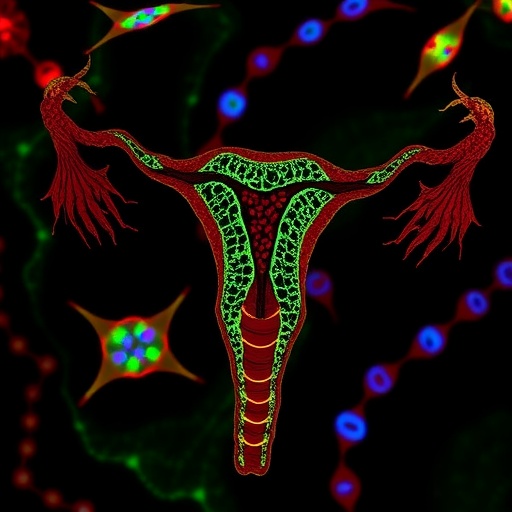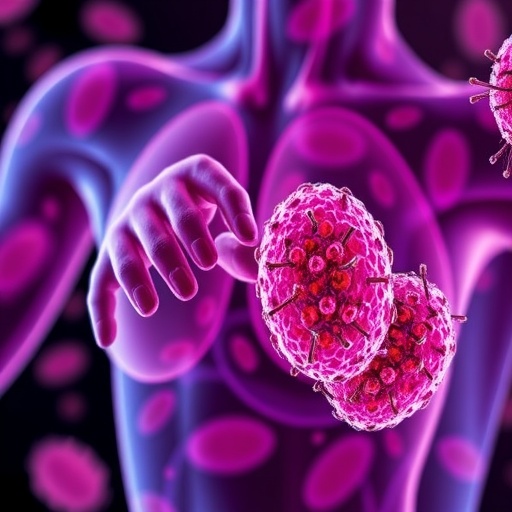In an era when advanced laser technologies continue to reshape medical treatments, a groundbreaking study has emerged, revealing a novel approach to retinal regeneration using safe, controlled laser exposure. Published recently in Nature Communications, the research led by Amirkavei, Kaikkonen, Turunen, and colleagues presents a pioneering technique that harnesses electroretinography-based thermal dosimetry to administer non-damaging laser treatment to the retinal pigment epithelium (RPE) in porcine models. This innovative method activates a hormetic heat response that could revolutionize how clinicians approach degenerative eye diseases, offering hope for enhanced retinal repair without causing harm.
The importance of safeguarding the intricate retinal structures while stimulating regenerative pathways has driven scientists to explore fine-tuned thermal treatments. Conventional laser therapies, while effective in managing certain retinal disorders, risk collateral damage leading to vision impairment. The novel electroretinography (ERG)-guided thermal dosimetry approach circumvents this issue by precisely quantifying thermal doses required to stimulate beneficial cellular responses without crossing thresholds that induce cell death or dysfunction. This distinction is critical, as it opens avenues to exploit the cell’s innate stress response mechanisms—hormesis—which promotes survival and repair when triggered within controlled limits.
At the core of this study is the integration of real-time electrophysiological monitoring via electroretinography with laser thermal dosing, effectively creating a feedback loop that ensures the retina receives the exact heat stimulus necessary to activate protective heat shock proteins. The RPE, a monolayer of cells essential to retinal health and function, responds to these controlled thermal cues by upregulating heat shock protein expression, thereby engaging molecular pathways that facilitate cellular repair, reduce oxidative stress, and bolster resilience against subsequent insults. Such finely controlled stimulation stands in stark contrast to the injurious heat overloads commonly associated with older laser methods.
The research methodology involved meticulous experimentation on pig RPE tissues, selected for their anatomical and physiological similarity to human retinal structures. Through systematic adjustments of laser parameters, the team established optimal thermal dosages that reliably elicited hormetic heat responses while preserving electrophysiological integrity—measured continuously with ERG. This careful titration facilitated identification of a “thermal sweet spot,” a dosage window where stress is beneficial rather than destructive. The concept of hormesis, long studied in other biological exposures such as radiation and chemical stress, finds a novel and promising application in photobiomodulation of retinal tissue.
An intriguing aspect of this work lies in its potential to translate into clinical therapies for age-related macular degeneration (AMD) and other retinal degenerative diseases. Traditional laser photocoagulation often exacerbates photoreceptor loss, but by leveraging the hormetic heat response without tissue damage, this new technique could promote endogenous repair while maintaining photoreceptor integrity. If successfully adapted for human application, it may represent a paradigm shift, enabling ophthalmologists to deploy laser interventions that harness the body’s own repair mechanisms rather than merely containing disease progression.
Furthermore, the precision afforded by incorporating ERG-based feedback opens prospects for personalized laser treatment regimens tailored to individual retinal responses. Given that retinal sensitivity and baseline function vary widely among patients, the dynamic adaptation of laser exposure based on live electrophysiological signals could optimize therapeutic windows, minimizing side effects and maximizing benefit. This personalized, data-driven approach embodies the convergence of bioengineering, ophthalmology, and regenerative medicine toward next-generation vision restoration modalities.
At a molecular level, the study highlights the upregulation of specific heat shock proteins, including HSP70, which are pivotal in maintaining protein homeostasis and mitigating apoptosis under stressful conditions. The activation of these molecular chaperones following controlled thermal stress aids in repairing misfolded proteins and stabilizing cellular structures, thus enhancing cell survival. By carefully controlling the thermal dose to trigger but not overwhelm these pathways, the treatment encourages a cellular environment conducive to regeneration, rather than degeneration, of the RPE.
The significance of electroretinography in this study cannot be overstated. ERG serves as a sensitive and non-invasive measure of retinal function, capturing electrical responses generated by photoreceptors and downstream neurons. Incorporating ERG as a real-time dosimetric tool enables continuous assessment of retinal electrophysiological status, providing immediate feedback on any detrimental effects of thermal exposure. This integration ensures safety and efficacy, a critical advancement over prior static dosing protocols that relied on fixed laser parameters without physiological validation.
By utilizing a porcine model, the researchers ensured translational relevance, since pig eyes closely mimic human retinal dimensions and physiology. This similarity affords meaningful extrapolation of findings, setting the stage for subsequent human clinical trials. The choice of an animal model also enabled robust histological and molecular analyses post-treatment, confirming preservation of RPE morphology and function at optimal thermal doses, while underscoring the delicate balance required in inducing hormesis without causing thermal injury.
The study’s findings suggest that hormetic heat response activation through controlled laser treatment could induce a network of cellular adaptations beyond heat shock protein expression, including enhanced antioxidant defenses, modulation of inflammatory pathways, and improved mitochondrial function. These collective effects may contribute to long-term retinal resilience and functional preservation, potentially slowing or even reversing the course of degenerative retinal diseases. Continued research will be needed to elucidate these downstream effects and optimize treatment parameters.
Looking ahead, the integration of advanced imaging modalities alongside ERG could further enhance dosimetry precision, offering multi-dimensional feedback on retinal health. Techniques such as optical coherence tomography (OCT) or Raman spectroscopy might complement ERG by providing structural or biochemical information in real-time. Combining these tools may refine treatment algorithms and enable clinicians to dynamically adjust laser parameters based on comprehensive retinal feedback, ushering in a new era of smart ophthalmic laser therapies.
In addition to clinical implications, this research advances fundamental understanding of retinal biology, demonstrating that mild thermal stress can serve as a non-pharmacological stimulus to activate endogenous protective pathways. This insight invites exploration of hormesis-inducing treatments in other neurodegenerative contexts, potentially extending benefits to disorders involving oxidative stress and protein misfolding beyond the eye. The interdisciplinary approach bridging laser physics, electrophysiology, and molecular biology represents a model for future translational breakthroughs.
Critically, the non-damaging nature of the laser treatment differentiates it from historical photocoagulation techniques that indiscriminately destroyed retinal tissue. By precisely harnessing sub-threshold thermal doses, the treatment minimizes unintended side effects such as scotoma formation or choroidal neovascularization. This refined approach aligns with evolving goals in ophthalmology to preserve vision and quality of life through minimally invasive, tissue-sparing interventions.
The research also raises interesting questions regarding optimal dosing frequencies and cumulative effects of repeated hormetic treatments. While a single exposure proved effective in activating heat responses, the potential for repeated applications to sustain or amplify therapeutic benefits warrants systematic investigation. Understanding the longevity of induced protective states and any risks of habituation or overstimulation will be key in designing clinical protocols.
Overall, this study exemplifies how marrying sophisticated electrophysiological monitoring with laser technology can yield transformative therapies that achieve tissue regeneration without injury. The demonstration of a hormetic heat response as a therapeutic target paves the way for new clinical paradigms that harness the body’s intrinsic repair mechanisms rather than relying solely on external pharmacological agents. Such innovations hold promise not only for retinal diseases but also for a broader range of degenerative conditions.
As this technology progresses toward human applications, collaboration between engineers, ophthalmologists, and molecular biologists will be vital. Addressing challenges such as precise laser delivery within the constraints of the human eye, patient-specific variability, and long-term safety will define the path forward. However, the foundational groundwork laid by Amirkavei and colleagues provides a compelling blueprint for success.
In summary, the convergence of ERG-based thermal dosimetry with controlled laser stimulation marks a major advance in retinal therapy. By activating hormetic heat responses within the retinal pigment epithelium at non-damaging levels, this innovative approach offers a promising new avenue for regenerative treatment of degenerative eye diseases. As the quest for safe, effective, and personalized ophthalmic interventions continues, this study stands as a testament to the power of precision medicine powered by bioelectrical feedback and thermal biology.
Subject of Research: Laser treatment efficacy and safety in retinal pigment epithelium using electroretinography-based thermal dosimetry.
Article Title: Non-damaging laser treatment with electroretinography-based thermal dosimetry activates hormetic heat response in pig retinal pigment epithelium.
Article References:
Amirkavei, M., Kaikkonen, O., Turunen, T., et al. Non-damaging laser treatment with electroretinography-based thermal dosimetry activates hormetic heat response in pig retinal pigment epithelium. Nat Commun 16, 9533 (2025). https://doi.org/10.1038/s41467-025-64095-6
Image Credits: AI Generated
Tags: collateral damage prevention in laser treatmentscontrolled laser therapies for vision preservationelectroretinography monitoring in ophthalmologyelectroretinography-based thermal dosimetryenhancing retinal repair through thermal stimulationhormetic heat response in retinal repairinnovative approaches to degenerative eye diseaseslaser treatment for retinal regenerationnon-damaging laser exposure techniquespioneering laser technologies in medicineregenerative pathways in retinal pigment epitheliumsafeguarding retinal structures during treatment





